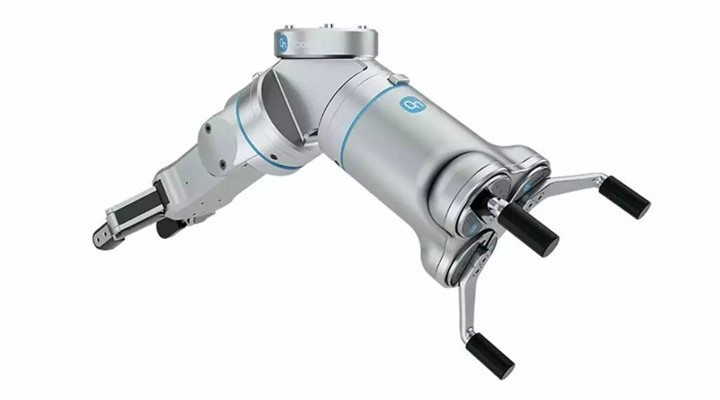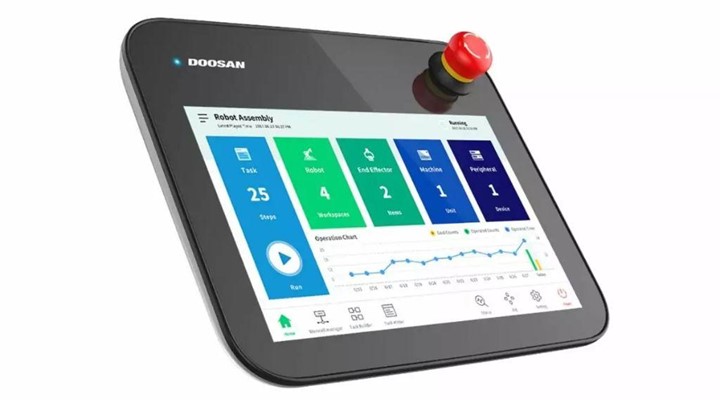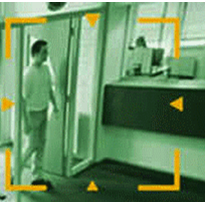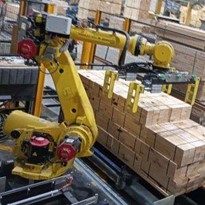We are all aware that we certainly have a lack of staff in Australia at the moment – manufacturers are crying out for welders or general manufacturing staff. There is definitely a shortage of staff, so that is where a cobot can do some of the heavy lifting or monotonous and boring tasks that you can’t find someone to do on a continuous basis.
Automating repetitive tasks and combatting labour shortages
Even applications like machine tending, as a lot of manufacturing is coming back to Australia, which can be CNC machining of tasks. Rather than having a person standing at a machine and waiting for it to finish a part, take it out, and put a new one in, a cobot can be doing that process. And not only doing it for 8 hours a day, but it could be doing it for 24 hours a day – load up magazines with your raw material and the cobot can (lights out if desired) stand there all day and night and feed the machine, take out the finished parts and stack it away. That is where the benefits really come in – it’s a game changer for a lot of small and medium manufacturers as it allows them to increase their productivity, quality of the finished product, and get the product that they manufacturer to their customers in a good time.
Speed of deployment
One of the other benefits is the time of deployment in the first instance (or for multiple applications). A lot of manufacturers at this point in time, with the function of supply chain issues (computer chips etc.), are struggling to get industrial robots. We are hearing from some manufacturers of a 6-12 month delay for industrial robots. Now, if someone wants to begin automating their processes today, they want to get a result sooner rather than later to achieve that return on investment. One of the advantages with our supplier Doosan is that we can get actual supply very quickly. Besides the stock that we keep ourselves, we know that we can get supply from Doosan fast, meaning that we can put a project and application together and have it actually deployed in a customer’s facility in the range of 8-10 weeks, depending on the application. That turnaround is unheard of when it comes to an industrial robotic application, so the benefit starts to flow to the manufacturer so much quicker – that speed of deployment is a key element for the customer, absolutely.
Ease of programmability and operator empowerment
One of the great things of cobots is that you do not need a degree in mechatronics, robotics, or coding to write a program for a cobot. It means that our customers can have one of their own staff do the programming. With a one day training program that we offer we can teach our customers how to program the robot to do quite complex tasks in a very simple way; the teach pendant that Doosan cobots have has a very logical and intuitive interface that allows users to see what they are doing, move the robot arm easily, put it into position and set them, and set different functions (open or close a gripper, for e.g.). So in terms of programming, a user can set a new program – develop a new program themselves – in a matter of half an hour, having a new process in place. That process is then saved and can be recalled at any time they need to come back and do that same job, and is a really significant difference as compared to an industrial robot. Most customers don’t have the skill available in their own team to write the code that would be required, which would mean you need to employ somebody or call our technicians and engineers out onto your site which can take time and money for industrial robots. With a cobot, customers can program it themselves and have that process operating very quickly. With cobot programming, you can code if you want to, but it is not required at all, and is an intuitive point-and-click type of application. It doesn’t require any coding requirements and is a simple process that anyone can be taught very quickly.
A part of the process that we go through with our project installation is training for our customers’ operators: we show them the set-up we are doing in the first place and certainly train them on how to set their own programs and program the cobot how perform their own functions. We believe that its vital that the operators feel that the cobot is a work mate for them, and they need the confidence to know how to program the cobot and not fear it – that is the beauty of a collaborative robot, as it is part of that process of debunking the fear of robotics, as we show the operator how easy they can program it themselves. It immediately empowers the operator to start looking for other applications, too, with often one application leading to many other applications once the operators see the potential. We’ve heard “hey boss, nobody wants to do that job. Why can’t we get a cobot to do that?”, and that is the flow-on effect that we often see with our customers.
Multiple end of arm tools and grippers per cobot
With OnRobot end of arm tooling system (and quick change) you can fit two tools to the end fo the cobot arm. For example, if you were doing machine tending, one tool could be set to grip the raw material to then place it into the machine, with the other tool set to take out the finish part. So within a single movement within the machine tool, we can take the finished part and set the raw material for the next process. Overall, it greatly speeds up the process for the machining centre, improving the productivity. Second to this, because the cobot is easily redeployed to other applications you need to be able to change the tooling very quickly. With the OnRobot quick changing mechanism, we can very quickly change from, for example, a finger-style gripper to a vacuum gripper with a simple clipping out of one and in with the other (plug and play) into the cobot, which will automatically sense the different tool being inserted and set the programming accordingly. So, from a redeployment perspective within an operation, it’s a very simple process which is another large benefit of the collaborative robot – easy to move around, deploy, and to change the tools to suit the specific application. You can have a sanding tool on the cobot doing sanding today and tomorrow you can have a different tool on it doing an assembly process, or any combination of applications specific to your requirements. It’s high adaptability is a major benefit as compared to special purpose or industrial robots, which are only set to do one specific process. They do them very well, but it will only do one job, whereas a cobot is closer to being a human – performing multiple functions on any given day. It’s very easy to get set up and operational in a matter of minutes.











-205x205.jpg)

